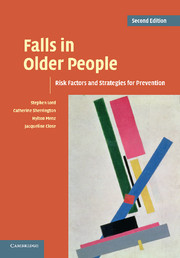Book contents
- Frontmatter
- Contents
- Preface
- Acknowledgements
- Part I Epidemiology and risk factors for falls
- Part II Strategies for prevention
- 10 Exercise interventions to prevent falls
- 11 Exercise interventions to improve physical functioning
- 12 Medical management of older people at risk of falls
- 13 Assistive devices and falls prevention
- 14 Modifying the environment to prevent falls
- 15 Prevention of falls in hospitals and residential aged care facilities
- 16 A physiological profile approach to falls risk assessment and prevention
- 17 Research into practice
- Part III Research issues in falls prevention
- Index
- References
17 - Research into practice
Published online by Cambridge University Press: 03 May 2010
- Frontmatter
- Contents
- Preface
- Acknowledgements
- Part I Epidemiology and risk factors for falls
- Part II Strategies for prevention
- 10 Exercise interventions to prevent falls
- 11 Exercise interventions to improve physical functioning
- 12 Medical management of older people at risk of falls
- 13 Assistive devices and falls prevention
- 14 Modifying the environment to prevent falls
- 15 Prevention of falls in hospitals and residential aged care facilities
- 16 A physiological profile approach to falls risk assessment and prevention
- 17 Research into practice
- Part III Research issues in falls prevention
- Index
- References
Summary
Over the past decade, some 50 randomized controlled trials for the prevention of falls in older people have been published. These have built on epidemiological and risk factor studies from the last 30–40 years, and provide strong evidence that falls can be prevented. Despite remaining gaps in the literature, the published research findings can be used to guide the development and delivery of clinical services to prevent falls in older people.
However, one of the challenges for those implementing falls prevention services is how to interpret the findings from research publications that have studied diverse populations of older people and have employed a multiplicity of interventions. Further, older people who present to healthcare systems are often not representative of populations studied in research settings. Unlike specific diseases such as osteoporosis, for which there is a clear definition, an agreed diagnostic gold standard and a limited range of treatment options, falls present more difficult diagnostic and therapeutic dilemmas. The previous chapters have identified and discussed falls risk factors and have considered the evidence on a range of approaches to prevention. This chapter synthesizes this evidence and collates the information in a format that can be used to facilitate the translation of research findings into routine clinical practice.
Screening versus assessment
As yet there is no firm data to support a population-based approach to the prevention of falls, and as such there is a need to identify appropriate populations in order to effectively target interventions and resources.
- Type
- Chapter
- Information
- Falls in Older PeopleRisk Factors and Strategies for Prevention, pp. 357 - 376Publisher: Cambridge University PressPrint publication year: 2007

